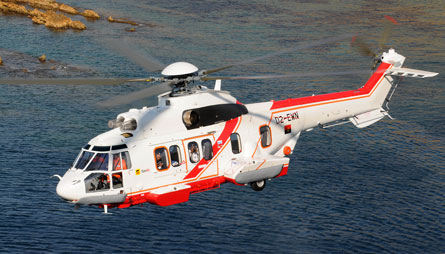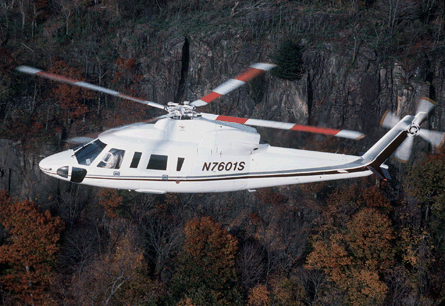Helicopter manufacturers are optimistic about growth in the Asia-Pacific region, despite the adverse impact on private helicopter orders during last year's financial downturn, believing that sales in key segments such as homeland security, military and search and rescue missions will continue to increase.
Eurocopter, which has 2,000 helicopters in Asia Pacific, sums up the region as the "number one helicopter market in the world". Its fleet in the area makes up about a quarter of its worldwide total, says Norbert Ducrot, Eucocopter's senior vice-president Asia Pacific sales. "We have 52% of the Asia-Pacific market," he adds.
Eurocopter's staff strength in the region has also more than tripled in recent years. From 480 in 2003, the company now employs more than 1,700 people in the region, says Ducrot.
 |
|---|
© AgustaWestland |
Fellow helicopter manufacturer Sikorsky has more than 500 aircraft operating in the region, with the majority of them from the Hawk family, says the company, while AgustaWestland has almost 400 machines in Asia Pacific in military and commercial roles, it says.
Last year's economic recession had dragged down orders in the private sector, but manufacturers say other growing segments have compensated for the loss. "As far as Asia Pacific is concerned, we were less affected than any region in the world," says Ducrot.
"We certainly see a drop in private orders, but the oil and gas, and search and rescue segments have been growing, so they have compensated for the fall in the private and commercial market," he adds.
Sikorsky has witnessed "some adverse impact on its VIP and corporate segment", but this was "more than offset by demand for military and homeland security products, given the role that helicopters play in the first response to natural disasters and terrorism", it says.
AgustaWestland says that despite the slowdown, its overall helicopter markets have been "substantially stable" in 2009, compared with the previous year when it delivered 226 helicopters. "The 2009 military and government market, as far as AgustaWestland is concerned, has maintained a strong trend and we also experienced growth regarding support and services," adds the company.
GROWING MARKETS
The public service market will help drive growth in the region in the years ahead, as developing countries in Asia Pacific continue to acquire new helicopters and modernise their existing fleets. "Newly developed countries like China and India are under-equipped at the moment," says Ducrot.
Among Eurocopters's recent deals in the market is the July 2009 delivery of the first EC225 to Vietnam's Southern Service Flight, which operates flights for search and rescue operations and emergency medical services.
Agreeing with Eurocopter, Sikorsky says it expects the homeland security segment to see the most growth in the year ahead. Last year, it sold the first S-76C to Shanghai Kingwing General Aviation of China. The aircraft will be used to support civil onshore rescue missons.
 |
|---|
© Patrick Penna/Eurocopter |
AgustaWestland expects to continue to see strong growth in segments such as air ambulance, law enforcement, coastguard, search and rescue, and civil protection markets.
"Types such as the AW119Ke, AW109 Power, Grand and AW139 helicopters have achieved significant sales success in several markets including Australia, China, Japan, Malaysia, New Zealand and South Korea," says the company.
Among AgustaWestland's recent deals in the region was the order of a third AW139 by the South Korean coastguard, which was finalised in December 2009.
The oil and gas sector is another market segment that has been identified as having more potential for growth. In 2008, Eurocopter signed a deal for 10 EC155 Dauphin helicopters with Shenzhen-based Citic Offshore Helicopter, which operates offshore transport missions in China. AgustaWestland says the offshore oil and gas helicopter market is strong, as oil companies and operators modernise their fleet. It delivered two AW139 medium-twin helicopters in November to Euro-Asia, an offshore helicopter operator in Kazakhstan. The aircraft will be used for transport in Kazakhstan's section of the Caspian Sea.
LEVERAGING
As the Asia-Pacific region continues to grow, helicopter manufacturers have busied themselves with establishing a presence in China.
Their business strategy has gone beyond selling as many helicopters as possible to Asia's economic giant, with many manufacturers having set up joint venture companies in the country to tap the growing market.
Eurocopter set up a subsidiary, Eurocopter China, in December 2006 to be closer to its Chinese customers. The subsidiary operates from bases in Beijing, Hong Kong, Shanghai and Shenzhen. In 2008, its revenue doubled to €6 million ($8.6 million) from €3 million in 2007.
To date, more than 150 Eurocopter helicopters have been sold by Eurocopter China. About 350 helicopters operate in China.
"China has a great growth potential in the civil and parapublic market. At Eurocopter, we are doing our best to reinforce our presence in this vast territory," says Eurocopter China's chief executive Bruno Boulnois.
AgustaWestland has established itself in China through a joint venture with China Aviation Industry (AVIC) to produce the AW109 Power (known as the CA109 in China) for the Chinese market. "We believe that the Chinese market is growing, and we are particularly interested in sales in inland China, as well as on the coast," says AgustaWestland chief executive Giuseppe Orsi. The company has sold almost 30 helicopters in China, and plans to establish itself as the market leader in the light and medium twin commercial markets.
 |
|---|
© Sikorsky |
Sikorsky established Shanghai Sikorsky in 2003 to drive sales and provide support in China. In 2008, AVIC subsidiaries Changhe Aircraft Industries and Shanghai Xinsheng Aviation Industry Investment and Development joined Shanghai Sikorsky as shareholders. Sikorsky has partnered AVIC to build components for the S-92, and Sikorsky and Changhe are also collaborating on the S-76.
Helicopter manufacturers have also stamped their names on other parts of the region. AgustaWestland and Sikorsky have signed agreements with India's Tata Group recently, with AgustaWestland signing a memorandum of understanding with Tata Sons in 2009 to form a joint venture company to set up a final assembly line for the AW119 in India.
Sikorsky has also agreed to start a joint venture with Tata Advanced Systems to manufacture aerospace components in India, on top of an existing contract to assemble S-92 cabins.
AgustaWestland has also set up a local subsidiary and support centre in Malaysia. Like Sikorsky, it is also involved in partnerships in Japan and South Korea. Eurcopter has nine subsidiaries in the Asia-Pacific region, and will open its tenth in the first half of this year.
"We are opening one subsidiary in the region every year, and two or three MRO centres in Asia every year," says Ducrot, who declines to reveal where the tenth subsidiary will be.
Eurocopter now has subsidiaries in Indonesia, Japan, the Philippines, Singapore and South Korea, among others.
Even as the helicopter market continues to grow in Asia Pacific, manufacturers have highlighted concerns about training and infrastructure in the region.
For one, the air infrastructure is not uniform across the region. Australia, Japan and South Korea are well developed, while China and India are "well-positioned for explosive growth", says Sikorsky. The other countries fall somewhere in between, it adds.
PILOT SHORTAGES
A shortage of trained pilots is also a problem. AgustaWestland is aiming to combat this by offering training services from its facility at Subang airport through its Malaysian subsidiary, and has provided full-flight simulators outside the region to international customers for the AW109 Power and AW139.
Eurocopter's Ducrot says there is a need for more trained pilots in Asia Pacific. "This is especially so in India and China," he says.
Eurocopter has partnered governments and the private sector to set up simulators in the region, he adds. The company's subsidiary in Malaysia has partnered the Malaysia International Aerospace Centre to build a helicopter centre in Subang, which will hold a full-flight simulator for the EC227/725. Training is due to start by the end of 2011.
"We have to contribute what we can to help train more pilots in the region," says Ducrot.
Source: Flight International
















